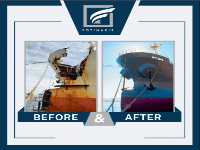Tariffs and Other Issues Contribute to Volume Declines for Antwerp-Bruges
Europe’s second-busiest port, Antwerp-Bruges, is facing one of its most challenging years in recent times, characterized by mounting crises that are significantly impacting performance. The port is reporting that global uncertainties, specifically the volatile trade environment, coupled with congestion, industrial actions, and altering shipping alliances, are having a material impact on its business.
Antwerp-Bruges released its first nine months’ performance figures that yet again reflect a trend that has become a norm this year, a decline in cargo throughput. During the period, the port saw its throughput decline by 3.8 percent to stand at 202.6 million tonnes. The dry and liquid bulk segments recorded the largest decline, while container and RoRo posted near flat growth.
The port is highlighting that the performance during the first three quarters paints a picture of mixed fortunes. Despite efforts to ensure it remains resilient, the port is feeling the pressure of mounting challenges. These cut across a volatile trade environment ignited by U.S tariffs and port congestion due reshuffling of container alliances and the Red Sea crisis that continues to force ships to reroute around the Cape of Good Hope. Recently, the port was also affected by a slowdown by the sea pilots, and at other times this year, other protests related to the government’s austerity efforts and proposed pension reforms.
Due to the challenges, performance across all segments has come under strain. Container throughput, which recorded a strong start in the first half of the year, lost some momentum from August onwards, resulting in third-quarter performance remaining at 2.4 percent below the level of the same period last year. Overall, the container segment performance recorded modest growth over the nine months, with tonnage rising by a paltry 1.1 percent to 113.5 million tonnes and TEU up by 1.6 percent to 10.3 million.
Antwerp-Bruges attributes the slow performance of the container segment to the normalization of container shipping alliances that brought an end to the temporary overlap between calls in old and new alliances. On the positive, the shifting alliances have led to a clear reduction in congestion in recent weeks, with quicker turnarounds and smoother traffic to the hinterland.
During the period, dry and liquid bulk cargo maintained its trend of decline. Dry bulk cargo plunged by 8.9 percent to 10.1 million tonnes driven primarily by weaker fertiliser shipments that declined by 1.1 percent. A doubling of Russian shipments in anticipation of new EU tariffs, alongside a growing share from alternative origin countries such as Morocco, prevented a bigger drop in the segment.
Antwerp-Bruges also recorded a drop in liquid bulk throughput that plunged by 13.5 percent to 55.9 million tonnes. A major cause was petroleum derivatives, which account for 62 percent of the segment, and which fell by 18 percent due to the loss of exports to West Africa as a result of stricter European regulations and lower imports from the United Kingdom. Liquefied natural gas also recorded a 15.1 percent drop due to the European ban on the transshipment of Russian gas. A bigger drop was partially offset by higher imports from the U.S.
Although the U.S maintained its status as Antwerp-Bruges’ second-largest trading partner, with shipments growing by 15 percent, the situation is at risk of change owing to tariffs. Impact is already being felt after exports fell in the third quarter, particularly for steel, which declined by more than a third compared to the second quarter. While container imports from the U.S also increased by eight percent, growth has slowed slightly since August.
“The quarterly figures highlight the resilience of Antwerp-Bruges in a particularly volatile economic climate,” said Jacques Vandermeiren, Port of Antwerp-Bruges CEO.
During the nine months, the port saw RoRo throughput increase 3.3 percent with a total of 2.34 million new vehicles handled. A total of 15,436 seagoing vessels called at the port, an increase of 2.8 percent. The cruise segment was not spared, with Zeebrugge recording a 4.9 percent decline in passenger numbers to 392,500. A total of 139 cruise ships called at the port, four fewer than last year.
Content Original Link:
" target="_blank">





















































